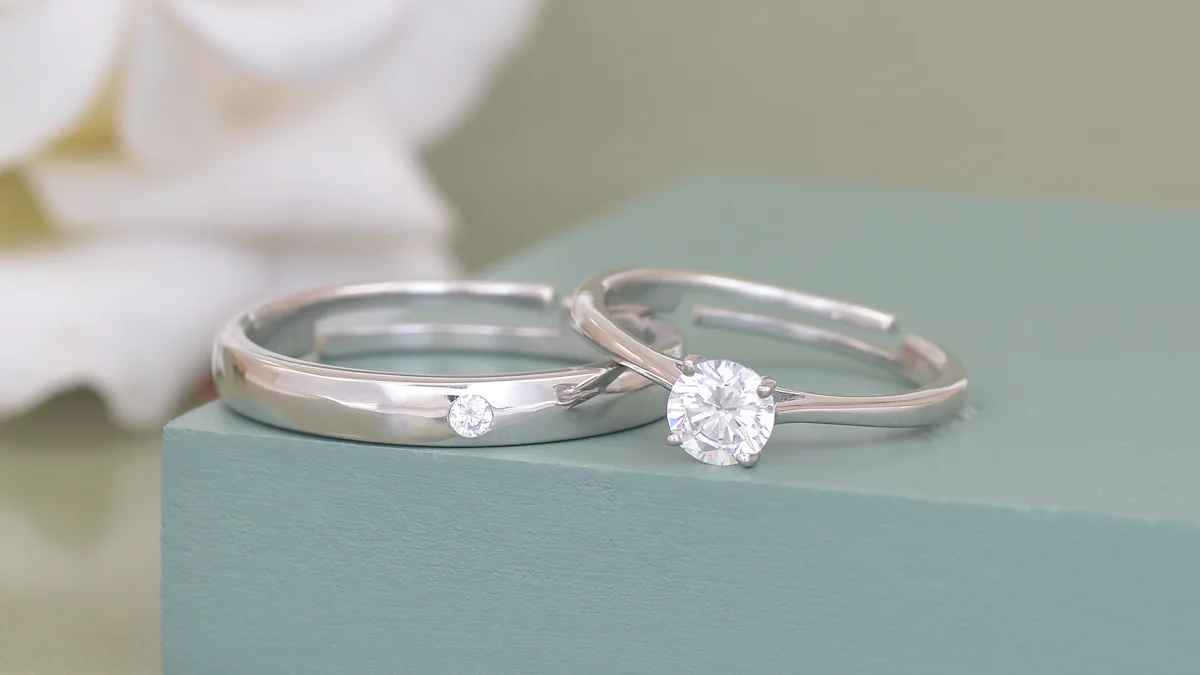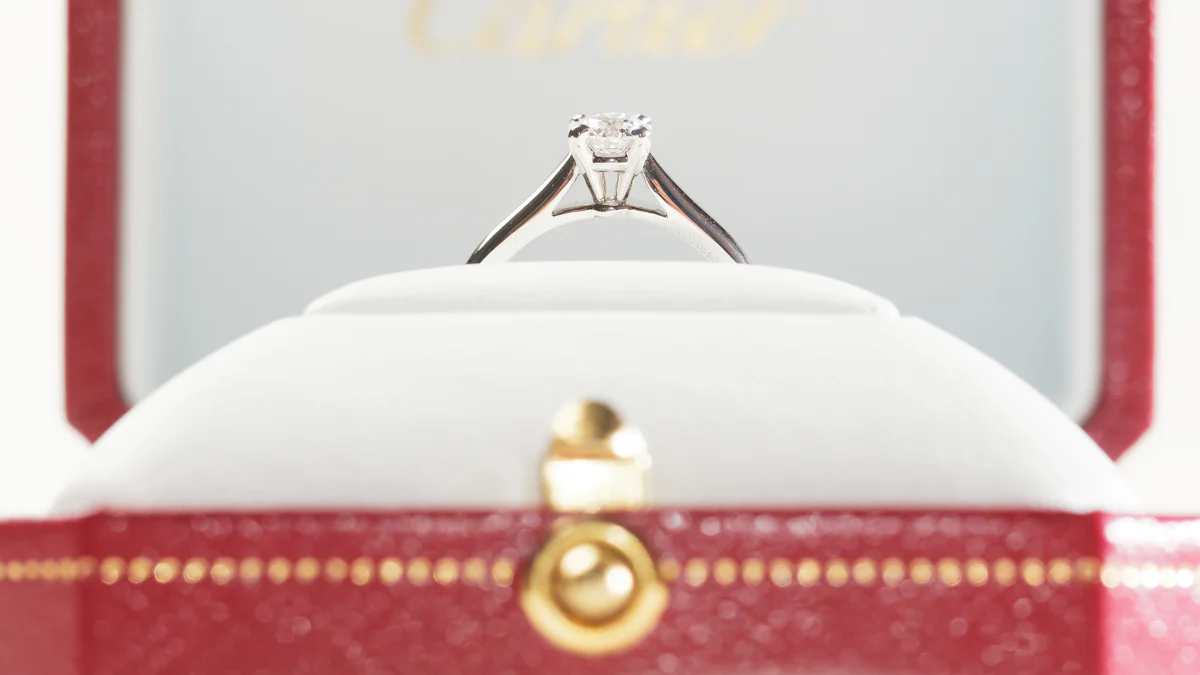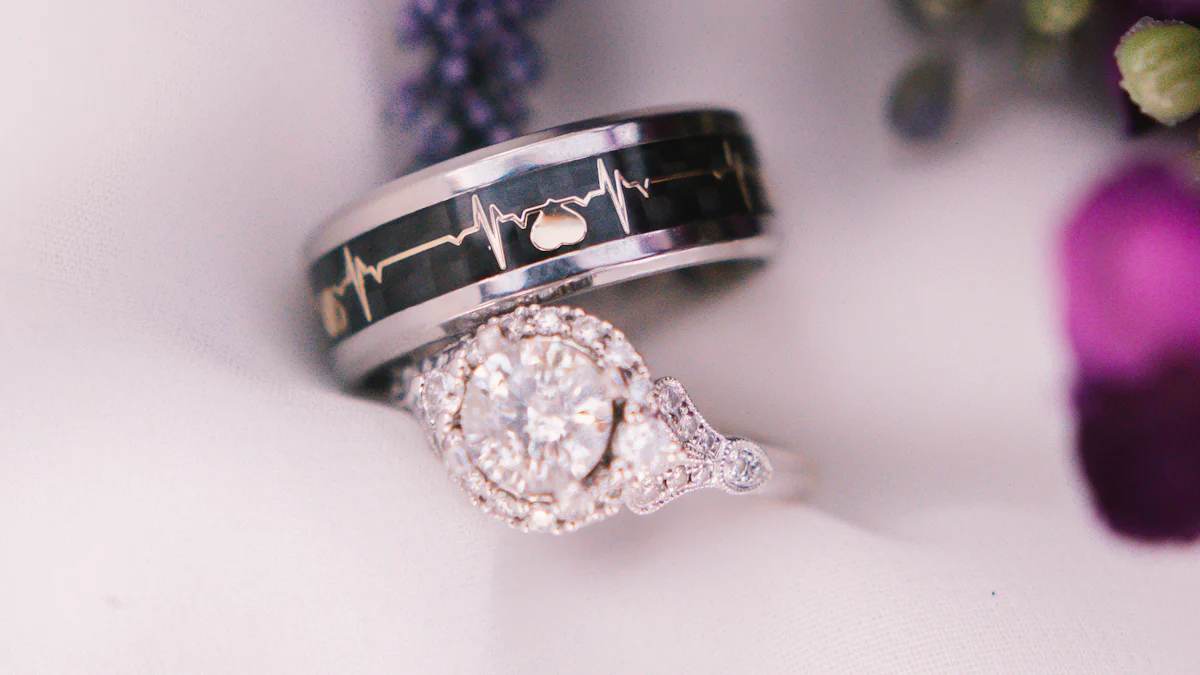Guide to 1-Carat Diamond Ring Settings

Choosing the right setting for your 1-carat diamond ring is crucial. It not only enhances the diamond's beauty but also reflects your personal style. Imagine how a halo setting can make your diamond appear larger, or how a classic prong setting can highlight its brilliance. Your choice in setting can dramatically transform the look of your ring. Consider your lifestyle too. A secure setting like a bezel might suit an active lifestyle better. Ultimately, the setting should resonate with your taste and ensure the longevity of your precious stone.
Key Takeaways
- Choosing the right setting enhances your diamond's beauty and reflects your personal style.
- Consider your lifestyle when selecting a setting; for active individuals, a bezel setting offers more protection.
- Popular settings like solitaire, halo, and pavé each provide unique aesthetics and benefits for showcasing your diamond.
- A prong setting maximizes light exposure, enhancing the diamond's brilliance, but requires regular maintenance to ensure security.
- Your budget is crucial; a solitaire setting can be more economical, allowing for a higher-quality diamond.
- Different settings can affect the perceived size and value of your diamond, with halo settings making it appear larger.
- Regular maintenance and professional checks are essential to keep your diamond ring secure and sparkling.
Understanding Diamond Settings
When you think about a diamond ring, the first thing that probably comes to mind is the sparkling diamond itself. But have you ever wondered what holds that diamond in place? That's where the diamond setting comes into play. Let's dive into what a diamond setting is and why it's so important for your 1-carat diamond ring.
What is a Diamond Setting?
A diamond setting is the metal framework that holds your diamond securely in place on the ring. It not only ensures the diamond stays put but also plays a big role in how the diamond looks. Different settings can change the way light interacts with the diamond, affecting its sparkle and brilliance. For instance, a halo setting surrounds the main diamond with smaller stones, adding extra sparkle and making the diamond appear larger. On the other hand, a bezel setting encircles the diamond with a thin metal rim, offering a modern look and sturdy protection.
The Role of a Setting in a 1-Carat Diamond Ring
The setting you choose for your 1-carat diamond ring can significantly impact its overall appearance and functionality. A well-chosen setting enhances the diamond's beauty and complements your personal style. For example, a channel setting places diamonds in a channel between two strips of metal, creating a sleek and secure look. This setting is perfect if you want a seamless line of diamonds along the band.
Moreover, the setting affects how practical the ring is for everyday wear. If you lead an active lifestyle, you might prefer a setting that offers more protection, like the bezel setting. It holds the diamond securely and reduces the risk of damage. Each setting style has its unique charm and benefits, so it's essential to consider what suits your lifestyle and taste.
Popular Setting Styles for 1-Carat Diamonds

When it comes to choosing a setting for your 1-carat diamond, you have several popular styles to consider. Each setting offers a unique way to showcase the beauty of your diamond. Let's explore some of the most favored options.
Solitaire Setting
The solitaire setting is a timeless classic. It features a single diamond as the centerpiece, allowing the stone to take center stage. This setting is perfect if you want your 1-carat diamond to be the star of the show. The simplicity of the solitaire setting highlights the diamond's brilliance and clarity. You can choose from different prong styles, like four or six prongs, to secure the diamond while maximizing its exposure to light. This setting is ideal for those who appreciate elegance and minimalism.
Halo Setting
If you want to add extra sparkle to your ring, consider the halo setting. This style surrounds the central diamond with a circle of smaller diamonds, creating a halo effect. The halo setting can make your 1-carat diamond appear larger and more dazzling. It's a great choice if you love a glamorous look. The additional diamonds enhance the overall brilliance and create a stunning visual impact. This setting is perfect for those who want their ring to stand out and make a statement.
Pavé Setting
The pavé setting offers a touch of sophistication and sparkle. In this style, small diamonds are set closely together along the band, creating a continuous glittering surface. The pavé setting adds a layer of elegance to your 1-carat diamond ring. It enhances the overall shine and gives the ring a luxurious feel. This setting is ideal if you want a ring that sparkles from every angle. The pavé setting is perfect for those who appreciate intricate details and a touch of glamour.
Each of these settings offers a unique way to enhance the appearance of your 1-carat diamond. Whether you prefer the classic elegance of a solitaire, the dazzling effect of a halo, or the sophisticated sparkle of a pavé, there's a setting style that will perfectly complement your diamond and personal taste.
Prong Setting
The prong setting is a classic choice for showcasing your 1-carat diamond. This setting uses small metal claws, or prongs, to hold the diamond securely in place. You often see four or six prongs used, depending on the design and desired look. The prong setting allows maximum light to enter the diamond, enhancing its brilliance and sparkle.
Why choose a prong setting? Here are a few reasons:
-
Visibility: The prong setting elevates the diamond, making it the focal point of the ring. This elevation allows more light to pass through the diamond, increasing its shine.
-
Versatility: You can pair a prong setting with various diamond shapes, such as round, princess, or oval. This flexibility makes it a popular choice for many.
-
Elegance: The minimal metal presence in a prong setting gives the ring a delicate and elegant appearance. It highlights the diamond without overwhelming it.
However, it's essential to consider a few things. Prong settings can snag on clothing or hair due to their elevated design. Regular maintenance is crucial to ensure the prongs remain secure and the diamond stays in place. Despite these considerations, the prong setting remains a favorite for those who want their 1-carat diamond to shine brightly and take center stage.
Factors to Consider When Choosing a Setting
When you're picking the perfect setting for your 1-carat diamond ring, several factors come into play. Let's break down the key considerations to help you make an informed choice.
Personal Style
Your ring should be a reflection of who you are. Do you lean towards classic elegance, or do you prefer something more modern and bold? If you love timeless beauty, a solitaire setting might be your go-to. It highlights the diamond's natural brilliance without any distractions. On the other hand, if you crave a bit of glamour, a halo setting could be the perfect match. It adds extra sparkle and makes the diamond appear larger. Remember, your ring is an extension of your personality, so choose a setting that resonates with your unique style.
Lifestyle Considerations
Think about your daily activities. Are you someone who's always on the move, or do you have a more laid-back lifestyle? If you're active, you might want a setting that offers more protection for your diamond. A bezel setting could be ideal. It encircles the diamond with a thin metal rim, providing sturdy protection against knocks and bumps. However, if you prefer a setting that maximizes sparkle, a prong setting might be more appealing. It allows more light to enter the diamond, enhancing its brilliance. Just keep in mind that prong settings can snag on clothing or hair, so regular maintenance is essential.
Expert Insight: "The prong setting, while offering less protection, is favored for its ability to allow more light into the diamond, accentuating its sparkle." - Diamond Settings Expert
Budget Constraints
Your budget plays a crucial role in determining the setting you choose. Some settings, like the pavé setting, involve additional diamonds, which can increase the overall cost. If you're working with a tighter budget, a solitaire setting might be more economical. It focuses on the central diamond, allowing you to allocate more of your budget towards a higher-quality stone. Remember, it's all about finding the right balance between your desired style and what you can comfortably afford.
Impact of Settings on Diamond Appearance

When you choose a setting for your 1-carat diamond, it does more than just hold the stone in place. The setting can transform how the diamond looks and feels. Let's explore how different settings can change the appearance of your diamond and enhance its perceived size and value.
How Settings Affect the Look of a 1-Carat Diamond
The setting you select plays a crucial role in how your diamond catches the light and sparkles. For instance, a prong setting elevates the diamond, allowing more light to pass through it. This maximizes the diamond's brilliance and makes it shine brightly. On the other hand, a bezel setting encircles the diamond with a thin metal rim. This offers a modern look and provides sturdy protection, though it might slightly reduce the diamond's sparkle compared to prong settings.
Different settings also highlight various aspects of the diamond. A halo setting surrounds the central diamond with smaller stones, creating a dazzling effect. This setting can make your 1-carat diamond appear larger and more impressive. The choice of metal for the setting, such as white gold or rose gold, can also affect the diamond's appearance. It can complement the diamond's color and enhance its overall look.
Perceived Size and Value Enhancement
Settings can significantly influence how large and valuable your diamond appears. A halo setting, for example, adds extra stones around the main diamond. This not only increases the ring's sparkle but also makes the central diamond look bigger. It's a clever way to enhance the perceived size without increasing the carat weight.
Survey Results:
- In 2022, nearly a third of respondents preferred the classic solitaire setting, which highlights the diamond's natural beauty.
- 65% of participants said their ideal carat weight for an engagement ring falls between 1 and 3 carats, showing a preference for substantial-looking stones.
The setting can also impact the perceived value of your ring. A pavé setting, with its continuous line of small diamonds, adds a layer of luxury and sophistication. This setting style can make your ring look more expensive and elegant. When choosing a setting, consider how it will enhance the diamond's size and value, ensuring it aligns with your personal style and budget.
Choosing the right setting for your 1-carat diamond ring is essential. It not only enhances the diamond's beauty but also reflects your personal style and lifestyle. Balancing these elements with your budget ensures a wise investment. Consider how different settings affect the diamond's appearance and durability. A prong setting might highlight brilliance, while a bezel offers protection. Always prioritize what resonates with you. Remember, the perfect setting will make your diamond shine and stand the test of time.
FAQ
What is the best setting for a 1-carat diamond ring?
The best setting depends on your personal style and lifestyle. If you prefer a classic look, a solitaire setting might be ideal. It highlights the diamond's natural beauty. For added sparkle, consider a halo setting. It surrounds the diamond with smaller stones, making it appear larger. If you lead an active lifestyle, a bezel setting offers more protection.
How does the setting affect the diamond's appearance?
The setting plays a crucial role in how your diamond looks. A prong setting allows more light to enter the diamond, enhancing its brilliance. A halo setting can make the diamond appear larger by adding surrounding stones. The choice of metal, like white gold or rose gold, also affects the diamond's appearance by complementing its color.
Can a setting impact the perceived value of my diamond?
Yes, the setting can influence how valuable your diamond appears. A pavé setting adds a layer of luxury with its continuous line of small diamonds. This style can make your ring look more expensive and elegant. A halo setting enhances the perceived size and value by adding extra stones around the main diamond.
What should I consider when choosing a setting for an active lifestyle?
If you're active, choose a setting that offers more protection. A bezel setting encircles the diamond with a thin metal rim, providing sturdy protection against knocks and bumps. It reduces the risk of damage while maintaining a modern look. Regular maintenance is essential to ensure the setting remains secure.
How does blue fluorescence affect a diamond's appearance?
Blue fluorescence can influence a diamond's appearance under different lighting conditions. While not extensively studied, some believe it can enhance the diamond's color, especially in colorless to faint yellow diamonds. It's important to view the diamond in various lighting to see how fluorescence affects its look.
Is a prong setting suitable for all diamond shapes?
A prong setting is versatile and works well with various diamond shapes, such as round, princess, or oval. It elevates the diamond, allowing more light to pass through and increasing its shine. However, prong settings can snag on clothing or hair, so regular maintenance is crucial.
How do I balance my budget with my desired setting?
Consider your budget when choosing a setting. Some styles, like the pavé setting, involve additional diamonds, increasing the cost. If you're on a tighter budget, a solitaire setting might be more economical. It focuses on the central diamond, allowing you to allocate more funds towards a higher-quality stone.
What are the most popular metals for diamond ring settings?
Common metals for settings include white gold, yellow gold, and rose gold. Each metal offers a unique look and can complement the diamond's color. White gold provides a modern and sleek appearance, while yellow gold offers a classic and timeless look. Rose gold adds a touch of romance and warmth.
How often should I have my diamond ring checked?
Regular maintenance is essential to ensure your diamond ring remains secure and beautiful. It's recommended to have your ring checked by a professional jeweler every six months. They can inspect the setting, tighten any loose prongs, and clean the ring to maintain its sparkle.
Can I change the setting of my diamond ring later?
Yes, you can change the setting of your diamond ring if you wish to update its look. Consult with a professional jeweler to explore different setting options. They can help you choose a new setting that complements your diamond and personal style.
See Also
Exploring Various Styles for Flower Engagement Rings
A Comprehensive Approach to Selecting White Diamond Rings
A Deep Dive Into Diamond Cuts for Engagement Rings

